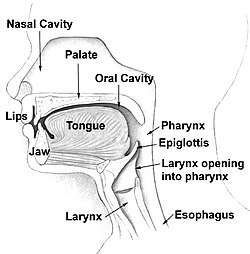Oropharynx
| Pharynx | |
|---|---|

Head and inner neck
|
|

Pharynx
|
|
| Details | |
| Artery | pharyngeal branches of ascending pharyngeal artery, ascending palatine, descending palatine, pharyngeal branches of inferior thyroid |
| Vein | pharyngeal plexus |
| Nerve | pharyngeal plexus, maxillary nerve, mandibular nerve |
| Identifiers | |
| Greek | Pharynx |
| MeSH | A03.556.750 |
| TA | A05.3.01.001 |
| FMA | 46688 |
|
Anatomical terminology
[]
|
|
The pharynx (plural: pharynges) is the part of the throat that is behind the mouth and nasal cavity and above the oesophagus and the larynx, or the tubes going down to the stomach and the lungs. The pharynx is an organ found in vertebrates and invertebrates, though the structure is not universally the same across all of those species.
In humans the pharynx is part of the digestive system and also of the conducting zone of the respiratory system. (The conducting zone also includes the nose, larynx, trachea, bronchi, and bronchioles, and their function is to filter, warm, and moisten air and conduct it into the lungs.) The pharynx makes up the part of the throat situated immediately behind the nasal cavity, behind the mouth and above the esophagus and larynx. The human pharynx is conventionally divided into three sections: the nasopharynx, the oropharynx and the laryngopharynx. It is also important in vocalization.
In humans there are two sets of pharyngeal muscles that form the pharynx, determining the shape of its lumen. These are arranged as an inner layer of longitudinal muscles and an outer circular layer.
The upper portion of the pharynx, the nasopharynx, extends from the base of the skull to the upper surface of the soft palate. It includes the space between the internal nares and the soft palate and lies above the oral cavity. The adenoids, also known as the pharyngeal tonsils, are lymphoid tissue structures located in the posterior wall of the nasopharynx. Waldeyer's tonsillar ring is an annular arrangement of lymphoid tissue in both the nasopharynx and oropharynx.
...
Wikipedia
